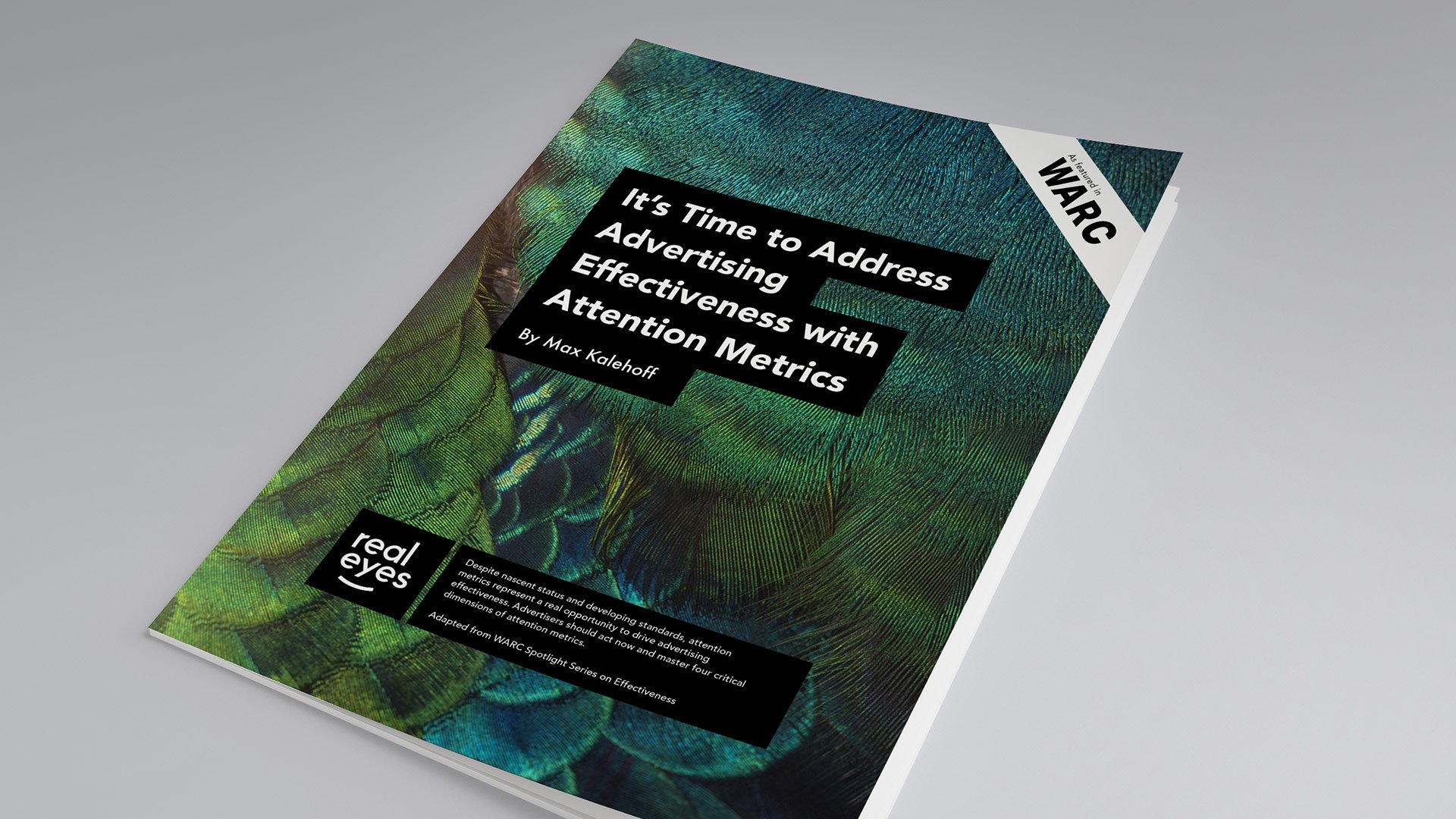
It’s Time to Address Advertising Effectiveness with Attention Metrics

Max Kalehoff
Despite nascent status and developing standards, attention metrics represent a real opportunity to drive advertising effectiveness. Advertisers should act now and master four critical dimensions of attention metrics.
![]()
(Adapted from WARC Spotlight Series on Effectiveness)
Attention in advertising links strongly to business outcomes
Recent research that Realeyes performed with the Teads revealed that a 5% increase in attention can result in a 40% lift in brand awareness. We also learned, in a study with a major electronics manufacturer, that high attention yields a 55% lift in shopping conversions. Realeyes’ partner Mars Inc. found that creative attention metrics drove up to 18% incremental sales lift in 19 markets, along with $30 million in ad optimizations in 18 months.
It’s no wonder that attention continues to gain more attention in the advertising industry, despite standards and definitions for attention metrics. Proof of adoption is the fact that 90% of senior advertising professionals report attention metrics are important, and more than 50% will invest in attention metrics this year, according to a 2022 Realeyes survey of 320 senior advertising professionals.
| Mars Inc. found that creative attention metrics drove up to 18% incremental sales lift in 19 markets, along with $30 million in ad optimizations in 18 months. |
Big Opportunities Despite Nascent Standards
Growing hype amidst a lack of standards is perhaps the biggest deterrent to faster, widespread adoption. But it should not impede testing attention measurement and realizing immediate advantage to advertising effectiveness. The first step for brands and agencies seeking competitive advantage is to establish their learning agendas around attention metrics – and get started now.
Making sense of attention metrics requires navigating four intertwined dimensions: 1) media versus creative attention; 2) attention data sources; 3) metrics and methodologies; and 4) attention metrics as inputs, outputs or both.
I detailed these four dimensions in a recent report for WARC’s Spotlight Series On Effectiveness. Below is a summary of each.
1. Media Versus Creative Attention
Media Attention
Many consider attention metrics as an extension of viewability hygiene. There is some truth to that, though attention is closer to a behavioral outcome, on the path to breakthrough, recall and brand impact. Conversely, a viewable impression is an “opportunity-to-see” – and has been subject to gamification.
Media pros are using attention metrics to plan and optimize campaigns better – and can fortify investment decisions around programming, or which ad formats and placements to prioritize. Some publishers and platforms are using attention metrics to better monetize inventory and demonstrate competitive value.
Creative Attention
No campaign can work without media, however creative is the largest driver of business outcomes, including sales. Advertisers have long evaluated creative for human response, and now creative attention metrics are becoming a foundation of effectiveness measurement. Creative attention metrics are ideal for advertisers who wish to optimize campaigns before their campaigns launch. Attention is a strong predictor of sales, so this method is enticing for brand-based businesses that struggle to connect offline sales data back to their advertising investments.
Creative and media attention metrics are complementary, yet necessary to drive the biggest gains in attentive reach.

2. Attention Data Sources: Humans Versus Impressions
Human Attention
One powerful example of human-sourced attention data is eyes-on-screen visual attention, which Realeyes specializes in. Visual attention is captured using front-facing cameras and computer vision software on the media devices of opt-in viewers. Other valuable data sources, albeit less scalable, include heart-rhythm monitoring and biometric headsets. Human data sources are attractive because they can overcome biases and fatigue associated with self-reported survey data.
Impression Proxies
Interaction signals at the impression level have long enabled viewability metrics and now are being used to approximate attention. They often are enhanced with human ground truth data, such as visual attention data. Because of their pervasiveness and granularity across campaigns, attention metrics developed from interaction proxies represent high potential for scale and granular campaign optimizations.

3. Types of Attention Metrics Methodologies
There are four main methodologies for attention metrics:
i) Probabilistic methodologies: These employ impression-level proxy signals to estimate the probable attention a given ad placement will generate, ideal for media planning and in-flight optimization.
ii) Predictive methodologies: They triangulate creative elements and other metadata from creative assets to predict relative attention in market, making creative attention testing potentially more ubiquitous, if lacking fidelity from pure observation.
iii) Observed attention methodologies: One example is computer vision tech used in a task-based research setting, where participants are asked to view a video or engage in an interactive media experience. Another example is “live-in-the-wild” measurement, where participants consent to having their devices passively detect attention on their media device in the background. For example, Realeyes recently launched Mindful.ly, an Android consumer app that detects users’ attentiveness and reactions through continuous visual attention detection.
iv) Hybrid methodologies: This describes when one measurement technique is used to strengthen another. For example, many probabilistic and predictive metrics today are strengthened with observed attention data. The future will bring more hybrid models, fusing different data sources and methods to create what matters most: sustained performance lift.
4. Effectiveness: Inputs versus Outputs
Attention metrics can be an effectiveness input (i.e., the probable strength of the creative), an effectiveness outcome (i.e., the delivery of necessary attention to achieve a goal), or both.
Attention measurement needs education and standards to flourish, and industry organizations are up to the task, including The Attention Council, the IAB, The Advertising Research Foundation and I-COM. While that happens, advertisers and agencies must not wait. Now is the time to establish learning agendas, test hypotheses and put validated methods into practice using attention metrics.
When it comes to testing and activation of attention metrics, there are several promising partners to consider. Below is a map of several attention leaders, organized according to key dimensions outlined above.
Related Resources:
WARC Spotlight Series: Time to Talk About Marketing Effectiveness
Realeyes Attention Leaders Series
Realeyes Attention Provider Directory

